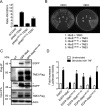Identification of a Distinct Substrate-binding Domain in the Bacterial Cysteine Methyltransferase Effectors NleE and OspZ
- PMID: 27445336
- PMCID: PMC5025698
- DOI: 10.1074/jbc.M116.734079
Identification of a Distinct Substrate-binding Domain in the Bacterial Cysteine Methyltransferase Effectors NleE and OspZ
Abstract
The type III secretion system effector protein NleE from enteropathogenic Escherichia coli plays a key role in the inhibition of NF-κB activation during infection. NleE inactivates the ubiquitin chain binding activity of host proteins TAK1-binding proteins 2 and 3 (TAB2 and TAB3) by modifying the Npl4 zinc finger domain through S-adenosyl methionine-dependent cysteine methylation. Using yeast two-hybrid protein interaction studies, we found that a conserved region between amino acids 34 and 52 of NleE, in particular the motif (49)GITR(52), was critical for TAB2 and TAB3 binding. NleE mutants lacking (49)GITR(52) were unable to methylate TAB3, and wild type NleE but not NleE(49AAAA52) where each of GITR was replaced with alanine restored the ability of an nleE mutant to inhibit IL-8 production during infection. Another NleE target, ZRANB3, also associated with NleE through the (49)GITR(52) motif. Ectopic expression of an N-terminal fragment of NleE (NleE(34-52)) in HeLa cells showed competitive inhibition of wild type NleE in the suppression of IL-8 secretion during enteropathogenic E. coli infection. Similar results were observed for the NleE homologue OspZ from Shigella flexneri 6 that also bound TAB3 through the (49)GITR(52) motif and decreased IL-8 transcription through modification of TAB3. In summary, we have identified a unique substrate-binding motif in NleE and OspZ that is required for the ability to inhibit the host inflammatory response.
Keywords: Escherichia coli (E. coli); NF-κB (NF-κB); infection; inflammation; substrate specificity.
© 2016 by The American Society for Biochemistry and Molecular Biology, Inc.
Figures








Similar articles
-
The type III effectors NleE and NleB from enteropathogenic E. coli and OspZ from Shigella block nuclear translocation of NF-kappaB p65.PLoS Pathog. 2010 May 13;6(5):e1000898. doi: 10.1371/journal.ppat.1000898. PLoS Pathog. 2010. PMID: 20485572 Free PMC article.
-
Cysteine methylation disrupts ubiquitin-chain sensing in NF-κB activation.Nature. 2011 Dec 11;481(7380):204-8. doi: 10.1038/nature10690. Nature. 2011. PMID: 22158122
-
The NleE/OspZ family of effector proteins is required for polymorphonuclear transepithelial migration, a characteristic shared by enteropathogenic Escherichia coli and Shigella flexneri infections.Infect Immun. 2008 Jan;76(1):369-79. doi: 10.1128/IAI.00684-07. Epub 2007 Nov 5. Infect Immun. 2008. PMID: 17984206 Free PMC article.
-
Cooperative Immune Suppression by Escherichia coli and Shigella Effector Proteins.Infect Immun. 2018 Mar 22;86(4):e00560-17. doi: 10.1128/IAI.00560-17. Print 2018 Apr. Infect Immun. 2018. PMID: 29339461 Free PMC article. Review.
-
Salmonella, E. coli, and Citrobacter Type III Secretion System Effector Proteins that Alter Host Innate Immunity.Adv Exp Med Biol. 2019;1111:205-218. doi: 10.1007/5584_2018_289. Adv Exp Med Biol. 2019. PMID: 30411307 Review.
Cited by
-
Regulatory Hierarchies Controlling Virulence Gene Expression in Shigella flexneri and Vibrio cholerae.Front Microbiol. 2018 Nov 9;9:2686. doi: 10.3389/fmicb.2018.02686. eCollection 2018. Front Microbiol. 2018. PMID: 30473684 Free PMC article. Review.
-
Bacterial Toxin and Effector Regulation of Intestinal Immune Signaling.Front Cell Dev Biol. 2022 Feb 16;10:837691. doi: 10.3389/fcell.2022.837691. eCollection 2022. Front Cell Dev Biol. 2022. PMID: 35252199 Free PMC article. Review.
-
Bacterial methyltransferases: from targeting bacterial genomes to host epigenetics.Microlife. 2022 Aug 10;3:uqac014. doi: 10.1093/femsml/uqac014. eCollection 2022. Microlife. 2022. PMID: 37223361 Free PMC article. Review.
-
Molecular mechanisms of Shigella effector proteins: a common pathogen among diarrheic pediatric population.Mol Cell Pediatr. 2022 Jun 19;9(1):12. doi: 10.1186/s40348-022-00145-z. Mol Cell Pediatr. 2022. PMID: 35718793 Free PMC article. Review.
-
NleB2 from enteropathogenic Escherichia coli is a novel arginine-glucose transferase effector.PLoS Pathog. 2021 Jun 16;17(6):e1009658. doi: 10.1371/journal.ppat.1009658. eCollection 2021 Jun. PLoS Pathog. 2021. PMID: 34133469 Free PMC article.
References
-
- Wong A. R., Pearson J. S., Bright M. D., Munera D., Robinson K. S., Lee S. F., Frankel G., and Hartland E. L. (2011) Enteropathogenic and enterohaemorrhagic Escherichia coli: even more subversive elements. Mol. Microbiol. 80, 1420–1438 - PubMed
-
- Frankel G., and Phillips A. D. (2008) Attaching effacing Escherichia coli and paradigms of Tir-triggered actin polymerization: getting off the pedestal. Cell. Microbiol. 10, 549–556 - PubMed
Publication types
MeSH terms
Substances
LinkOut - more resources
Full Text Sources
Other Literature Sources
Medical
Molecular Biology Databases
Miscellaneous

